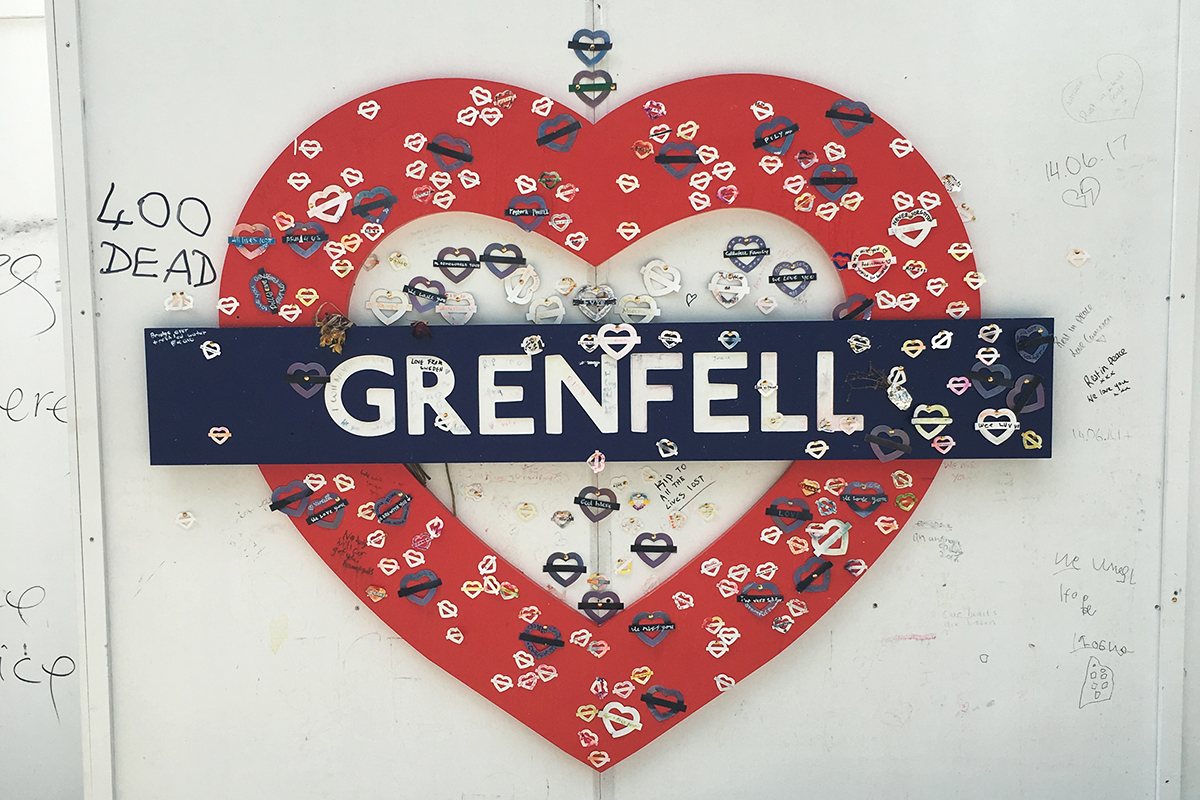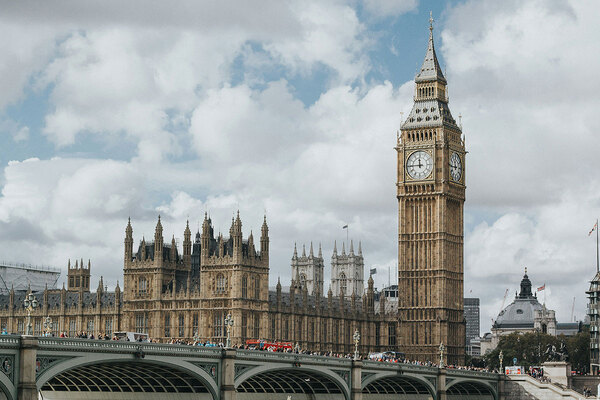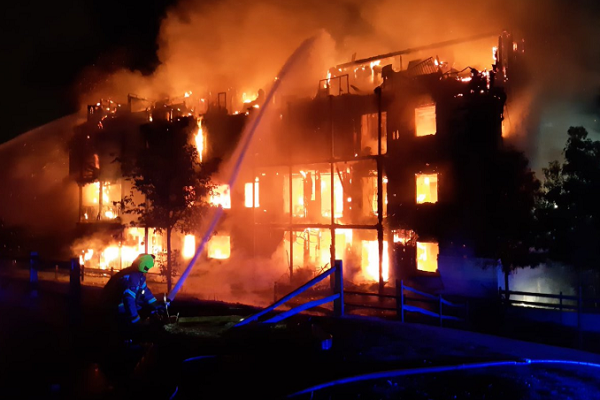Grenfell bereaved threaten legal action over government failure to implement inquiry changes for disabled people
Bereaved family members of the Grenfell Tower fire have threatened the government with legal action over its “misleading and inadequate” proposal not to implement inquiry recommendations relating to the evacuation of people with disabilities from tower blocks.
In a letter sent to the Home Office last week, the government was warned that action would be taken if it continued to pursue its plans not to implement in full the proposal that all vulnerable residents of high rises be provided with a written evacuation plan.
The legal action being considered is in the name of the family of Sakina Afrasehabi, a woman with severe mobility issues who lived on the 18th floor of the tower and died in the blaze with her sister as she was unable to escape the burning building.
Nazanin Aghlani, one of Ms Afrasehabi’s five children, told Inside Housing: “We were so happy [with the recommendation]. It was a relief to see Sir Martin Moore-Bick [chair of the inquiry] acknowledge us and what we were saying needed to happen. But then nothing happened – it’s devastating and very difficult because you almost think, ‘what is the point of the inquiry?’”
She said the provision of an evacuation plan was a matter of “life and death” to her mother, who had severe arthritis and other mobility issues and would not have been able to navigate the stairs.
Ms Afrasehabi was housed on the 18th floor of Grenfell Tower after spending 16 years on the housing waiting list, despite the Royal Borough of Kensington and Chelsea (RBKC) being aware of her mobility issues (see box below).
Ms Aghlani added that had RBKC been obliged to provide a personal emergency evacuation plan (PEEP), her mother would not have been housed in Grenfell Tower.
She said: “Her assessment from the council said she shouldn’t be housed above the fourth floor in a lifted building. We always worried about how she would get out if the lifts didn’t work.”
Why Sakina Afrasehabi was housed in Grenfell Tower
- From 1998, Ms Afrasehabi lived in a two-bedroom flat on the second floor of a building in Ladbroke Grove, west London. The flat had 42 steps to the front door and no lifts, meaning it was unsuitable for Ms Afrasehabi who had mobility issues resulting from an accident as well as severe arthritis.
- Her family applied for a council housing transfer in 2000 to a more suitable home. In March 2003, a council assessment confirmed she should be rehoused in a property with no more than six steps or in a lifted property no higher than the fourth floor.
- By 2012, after more than a decade on the waiting list, the family instructed a solicitor to help push for her to be moved to an accessible home. Ms Afrasehabi was made ‘high priority’, and following a review by the council it was recommended that she be housed in step-free accommodation.
- In 2014, she had a bid accepted for a new build property with step-free access. But before she moved in, the council instigated an investigation claiming falsely that her daughter – her live-in carer – did not live with her and that she had in fact been under-occupying her two-bedroom flat. Investigators arrived unannounced at the flat to count toothbrushes and check the wardrobes. Ms Aghlani recalls being spoken to “like we were criminals”. “[My mother] was scared that this could happen again. She did not sleep. She was traumatised. She was someone who had great faith in the police and institutions, in the Queen, but she was very scared,” she recalled in her witness statement. The family were interrogated by investigators and suspended from the bidding system. They lost the flat.
- By November 2014, the investigation was suspended with no wrong-doing found and the family were able to bid again on properties – but were told they could only bid for studio flats
- She was eventually offered accommodation on the 18th floor of Grenfell Tower in early 2016, and told if she did not take it she would be suspended from the bidding system entirely. “I had deep worries at the time but I buried them in the back of my mind. I did not want to even contemplate what would happen if a fire ever happened,” said Ms Aghlani.
- Less than 18 months later, Ms Afrasehabi and her sister died in the fire after being advised to ‘stay put’ by the fire service.
Source: witness statement of Nazanin Aghlani, available here.
In October last year, Sir Martin presented 22 recommendations as part of his report into the events of the night of the fire, which was aimed at preventing a repeat of the tragedy.
These included a recommendation that the owner and manager of every high rise be legally required to prepare PEEPs for “all residents whose ability to self-evacuate may be compromised”.
This was based on a consensus among three of the four fire safety experts advising Sir Martin, and the government responded with an unequivocal statement that it would accept all of the recommendations in full.
This claim was repeated by prime minister Boris Johnson in a speech on the third anniversary of the fire when he said: “We’re working to implement every recommendation made by the first phase of the inquiry.”
However, when a consultation on the implementation was published in July, it rowed back from this proposal and recommended that such plans be drawn up only for those in buildings with a waking watch, essentially those that are known to have fire safety defects such as dangerous cladding.
The government justified this on the basis of the lack of personnel available to assist an evacuation, the complexity of buildings, turnover of residents and data protection.
It recently whipped its MPs to defeat a push by the Labour Party to fully implement the recommendations of the inquiry, with Felicity Buchan new Conservative MP for Kensington, where Grenfell is located, voting against the implementation.
The letter to the Home Office, written by the family’s lawyer, Bhatt Murphy, said applying it in this way would effectively “disapply” the recommendation for 97% of the high rise residents in need of a PEEP.
“While the consultation document identifies that it is departing from the inquiry recommendation, it claims that the proposal ‘gives effect to the underlying objective of the inquiry’s recommendation’.
“This is misleading and inaccurate… This recommendation was patently not premised on the additional risk in [buildings with Grenfell-style cladding]. Rather the proposal was founded on the evidence (including expert evidence) of inherent risk of breach of compartmentation in high-rise buildings generally.
“The chair was fully aware and indeed explicitly acknowledged that fires of the type that occurred at Grenfell Tower were rare… but he nevertheless considered it necessary to urgently recommend a system of PEEPs in all such buildings.”
Ms Alghani added: “It’s something we are going to keep fighting for. My mum can’t die in vain, We will push and we will fight even if it saves one person in the future because just one person means so much to so many people.”
The letter gave the Home Office seven days to respond and said the family was “open to resolving this matter without recourse to judicial review” if possible.
A Home Office spokesperson said: “We have received this pre-action letter and are considering our response. It would be inappropriate to comment further at this stage.”
A spokesperson for RBKC said: “Grenfell is a tragedy that should not have happened and can never happen again, and our first and last thoughts will always be with those who lost their lives, their families and their friends. Nothing we do now can change the events of 14 June 2017, but stark lessons have been learned and we continue to change.
“Since the tragedy, we have installed premises information boxes on all buildings over 30m and will have added them to all buildings over 18m by the end of 2020; offered residents in high-rise buildings a fire risk assessment, emergency evacuation information and personal emergency evacuation plans where required; and put in place a new specialist fire safety team and fire risk management strategy.”
Sign up for our weekly Grenfell Inquiry newsletter
Each week we send out a newsletter rounding up the key news from the Grenfell Inquiry, along with the headlines from the week
Already have an account? Click here to manage your newsletters














